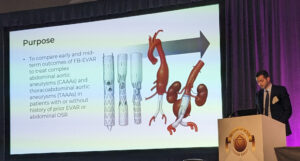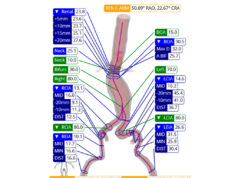
Presenting award-winning new research, Andrea Vacirca, MD, a research fellow at The University of Texas Health Science Center in Houston (UTHealth Houston), revealed how, despite prior records which demonstrate that fenestrated-branched endovascular aortic repair (F/BEVAR) is “feasible and safe” in patients with failed aortic repairs, few studies have outlined the “granular data” to support this claim, which his team aimed to provide through their analysis.
Vacirca was speaking during the opening scientific session at the 2023 Society for Clinical Vascular Surgery (SCVS) Annual Symposium in Miami (March 25–29), where he picked up the Peter B. Samuels Award for work looking at early and midterm outcomes of F/BEVAR in patients with or without a prior history of EVAR or open repair. And he set a course for his team’s main conclusions, first highlighting the “increasingly utilized” F/BEVAR’s “high” technical success and “low” mortality rates in the study population.
Vacirca and colleagues had set out to compare these outcomes of EVAR on complex abdominal aortic aneurysm (AAA) and thoracoabdominal aortic aneurysms (TAAAs) in a prospective, non-randomized analysis of clinical data from 502 enrollees. They reviewed outcomes in 376 patients with no previous aortic repair (controls), 54 who had prior EVAR (group one) and 72 with prior abdominal open repair (group two).
The researchers reported on 30-day mortality and MAEs, patient survival and freedom from aortic-related mortality (ARM), secondary interventions, any type II endoleak, sac enlargement (≥5mm), and new-onset dialysis.
Their results showed that EVAR was performed on average 7±4 and 12±6 years after the prior EVAR and abdominal open repair, respectively, with a complex AAA extent in 29% (143) of patients and TAAA in 72% (359) of patients. Breaking this down, Vacirca remarked that patients with prior open repair more frequently experienced TAAA, which were also “more extensive” when compared with the other two groups. However, freedom from Type II endoleak and sac enlargement greater than 5mm, was “significantly lower” in patients with prior EVAR, Vacirca told SCVS 2023.
Continuing, he remarked that these abdominal open repair patients were younger at index procedure, and showed “lower” survival and freedom from new-onset hemodialysis which—when prompted on why the latter had occurred during audience discussion—raised a “very important” question for Vacirca and his team. “We evaluated this aspect—if new-onset dialysis was related with lower survival in group two. But we found that only four patients experienced this, and so we associated lower survival with more extensive aortic disease.”
Overall technical success, mortality, and MAE rates were 96%, 1%, and 28% respectively, Vacirca outlined, though patient survival after 30-month follow-up was “significantly lower” in patients with prior open repair and was reported to be 45% at five years, consistently falling behind the other two groups.
“These procedures carry many technical challenges,” Vacirca stated, their data tentatively weighing up F/BEVAR and open repair for these complex patients. Allowing their research to speak for itself, Vacirca and his team offered an insight into their working practices, describing their hybrid operating room. “Our technique has evolved over the years […] We prefer a total femoral approach, without prophylactic drain whenever possible. We often request a preloaded system, and we now move to use the unibody fenestrated bifurcated devices, and we often double stent vessels coming from the suprarenal fixation devices,” Vacirca explained, making clear that procedural methods must continually be revaluated, and a hybrid approach adopted to provide the best treatment pathway for each individual in this complex patient population.












